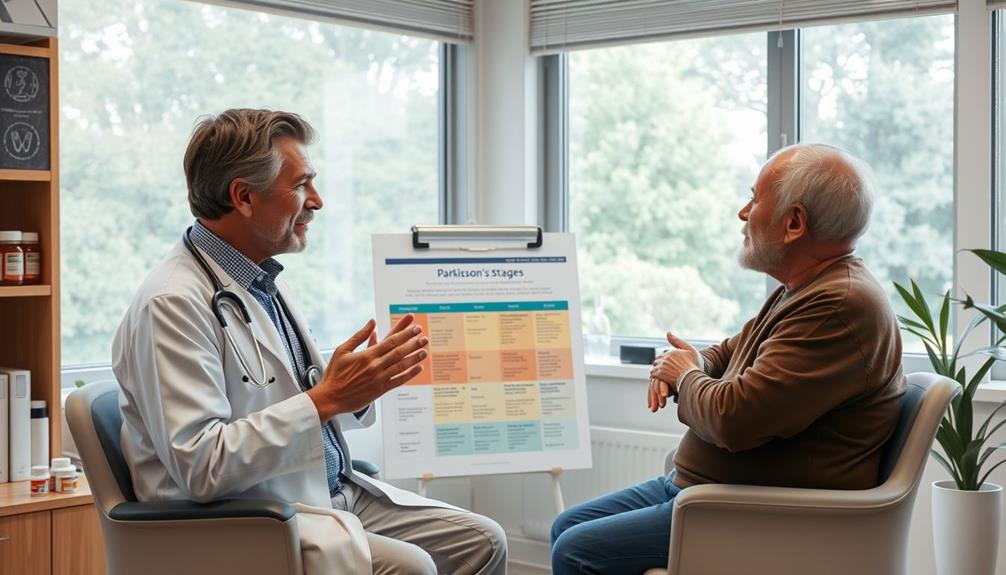Understanding the stages of Parkinson's disease helps you anticipate the changes ahead. The disease typically progresses through five stages, starting with mild symptoms on one side of your body and eventually leading to severe functional impairment and the need for care. As you move through these stages, you might experience tremors, rigidity, and balance issues. Non-motor symptoms, like depression or sleep disturbances, can also affect your quality of life. Staying informed about treatment options and support resources is key to managing your journey with Parkinson's. There's much more to discover about living with this condition and how to cope effectively.
Key Takeaways
- Parkinson's Disease progresses through five stages, starting with mild symptoms and advancing to severe functional impairment requiring full-time care.
- Stage 1 features slight tremors and minimal impact on daily activities, primarily affecting one side of the body.
- In Stage 2, symptoms become more pronounced, affecting both sides and causing difficulties with daily tasks while allowing for independent living.
- Stage 3 is marked by significant balance decline and increased fall risk, leading to mild to moderate disability.
- Advanced stages, 4 and 5, involve severe symptoms and require assistance for daily activities, with Stage 5 potentially resulting in bedridden states.
Overview of Parkinson's Disease

Parkinson's disease (PD) is a complex condition that affects the brain's ability to control movement. This progressive neurodegenerative disease primarily stems from the loss of dopamine-producing neurons in the substantia nigra region of the brain. When you first notice symptoms, you might experience a slight tremor in one hand, muscle rigidity, or bradykinesia, which is characterized by slowness of movement. Changes in posture and balance can also be early indicators. As the disease progresses, symptoms may worsen, affecting not only movement but also other functions, such as speech and cognitive abilities. While the exact cause of Parkinson’s disease is not fully understood, both genetic and environmental factors are believed to play a role. **Genetic testing in Parkinson’s disease** can help identify specific mutations linked to the condition, particularly in cases with a family history, offering insights into personalized treatment approaches and potential risk for relatives.
Additionally, factors such as emotional and psychological growth can influence how individuals cope with the diagnosis and progression of the disease, highlighting the importance of support systems and developmental milestones in managing overall well-being.
It's important to recognize that PD isn't just about motor symptoms; non-motor symptoms like depression, sleep disturbances, and cognitive decline can greatly impact your quality of life. These non-motor symptoms may even appear before the motor symptoms do.
As the disease progresses, the Hoehn and Yahr scale can help classify the severity of your condition, ranging from mild symptoms affecting one side of the body to severe disability requiring full assistance. With approximately 1 million people in the U.S. affected, the risk of developing Parkinson's increases greatly as you age, particularly if you're over 60.
Understanding these aspects of PD can help you and your loved ones navigate the journey ahead.
Stages of Parkinson's Disease

As you navigate the journey of Parkinson's disease, understanding its stages can be essential for managing your symptoms and planning for the future. The stages of Parkinson's disease, as defined by the Hoehn and Yahr scale, highlight disease progression and functional impairment. Here's a quick overview:
| Stage | Symptoms of Parkinson's Disease |
|---|---|
| Stage 1 | Mild symptoms; affects one side of the body; minimal impact on daily activities. |
| Stage 2 | More pronounced symptoms; affects both sides; difficulty with daily tasks, but you can still live independently. |
| Stage 3 | Significant decline in balance and reflexes; increased risk of falls; mild to moderate disability. |
| Stage 4 | Severe symptoms; significant functional impairment; may require assistance with daily activities. |
| Stage 5 | Advanced stage; might be bedridden or need a wheelchair; requires around-the-clock care due to severe motor and non-motor symptoms. |
Understanding each stage helps you anticipate changes in movement symptoms and take proactive steps to maintain your quality of life.
Early Symptoms and Diagnosis

In the early stages of Parkinson's disease, you might notice subtle changes that can easily be overlooked. These early symptoms often include a slight tremor in one hand, muscle stiffness, and bradykinesia, which is the slowing of movement.
Sometimes, you may experience non-specific symptoms like sleep disturbances or a reduced sense of smell, but they mightn't be enough for a definitive diagnosis. Additionally, individuals with Parkinson's may also face emotional challenges, similar to those experienced by people with BPD's emotional dysregulation that can complicate their overall well-being.
It's essential to seek a thorough evaluation by healthcare professionals if you suspect these changes. A neurological examination will help assess your symptoms and medical history, as there's no single test to confirm Parkinson's disease.
The Hoehn and Yahr scale is commonly used during this process to classify the severity of symptoms, providing insight into the progression of the disease.
Recognizing these early symptoms and obtaining a timely diagnosis can greatly enhance your management and quality of life. By addressing Parkinson's disease early on, you can enable timely intervention and support, ultimately making a positive impact on your journey with this condition.
Treatment Options and Management

There are various effective treatment options available for managing Parkinson's disease, focusing on alleviating symptoms and improving your quality of life. One of the primary medications is levodopa, which helps replenish dopamine levels in your brain and is often the first line of treatment.
Alongside medication, non-pharmacologic interventions like physical therapy and occupational therapy are essential. These therapies help maintain your mobility, daily living skills, and communication abilities. Additionally, engaging in regular exercise recommendations can enhance overall well-being and support symptom management.
For advanced cases where medication isn't sufficient, surgical options such as deep brain stimulation can greatly enhance your quality of life. Regular exercise, especially aerobic activities, is important too; aiming for at least 150 minutes of moderate-intensity exercise per week can help slow disease progression and boost your overall health.
It's important to maintain ongoing communication with your healthcare providers, as they play a crucial role in monitoring your condition. They can adjust treatment plans as the disease progresses and address any emerging symptoms.
Support and Resources for Patients

Finding support and resources is essential for anyone managing the challenges of Parkinson's disease. Connecting with others who understand your experience can greatly enhance your journey.
Additionally, understanding the financial aspects for elder care, such as assisted living expenses, can provide peace of mind as you navigate this path.
Here are some valuable resources to reflect on:
- Support Groups: Join local or online support groups to share experiences and foster a sense of community.
- Parkinson's Foundation: Access thorough educational resources, including webinars and newsletters, to stay informed about treatment options and research.
- American Parkinson Disease Association: Engage with local chapters that organize exercise classes and social events, promoting both physical and emotional well-being.
- Caregiver Support Services: Utilize respite care options and counseling services to help caregivers manage their emotional and physical demands.
- Michael J. Fox Foundation: Explore research initiatives aimed at advancing treatments and finding a cure, providing hope for patients and families.
Frequently Asked Questions
How Long Does It Take to Go From Stage 4 to Stage 5 Parkinson's?
It usually takes you about 2-5 years to shift from Stage 4 to Stage 5 in Parkinson's. However, each person's experience varies, so your journey might be quicker or slower depending on individual circumstances.
What Are the 5 Stages of Parkinson's?
You might think understanding Parkinson's stages is challenging, but it's essential. The five stages range from mild symptoms on one side to severe mobility issues needing full-time care, guiding your awareness and support needs effectively.
What Does Stage 2 Parkinson's Look Like?
In Stage 2 of Parkinson's, you'll notice more pronounced symptoms affecting both sides of your body. You might experience muscle stiffness, balance issues, and softer speech, but you can still manage daily activities with effort.
What Can I Expect With Stage 4 Parkinson's?
In Stage 4, you'll face severe motor symptoms, needing assistive devices for mobility. Daily activities might require help, and you could experience falls and cognitive decline, demanding around-the-clock care for safety and support.
Conclusion
To summarize, understanding the stages of Parkinson's disease helps you navigate its complexities and prepare for what lies ahead. It's important to know that approximately 1 million people in the U.S. are living with Parkinson's, and that number is expected to rise as the population ages. By staying informed about early symptoms, treatment options, and available support, you can take proactive steps in managing this condition and enhancing your quality of life.









